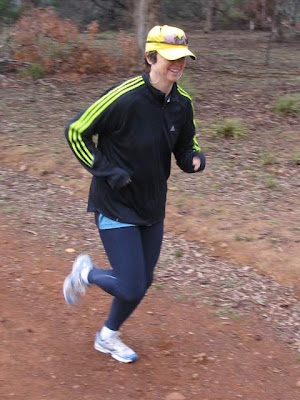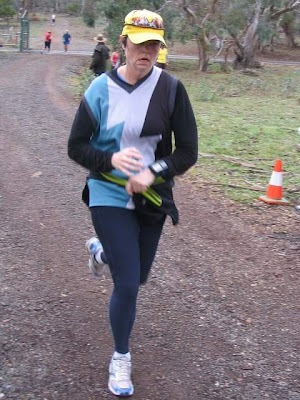Thursday training at Dickson: Our training session yesterday consisted of a 5k run at a good pace, picking it up along the home straight each time, the wind behind us, 100m in every 400. So rather than jogging and sprinting, we ran at a good tempo pace, with surges. Present were Beryl, Brett L, Brett M, Bronwyn, Craig, me, Heidi, Janene, Jerry, Miranda, Rod, Roger, Ruth, Suzie & Troy. We outnumbered the Bilbys again! This time, 15-12. That’s a win!
I passed on some form tips to a few of the runners last night. I notice a tendency with many runners to have their arms very high, and lock their elbows, which causes the arms to swing across the body, the hands to cross the centre-line of the body, shoulder sway, as well as tension in the neck and shoulders. A more relaxed, more efficient way of running is to have the arms lower, driving more in a straight line, and the arms not just driving forwards but pulling backwards.
So that the shoulders do not sway, as the arms move the elbows have to flex. In other words, the elbows need to be unlocked; i.e. the angle between the forearm and the upper arm needs to change as you run. As an arm is driven forward, the hand and forearm reach forward, and the angle of the elbow increases. As an arm is pulled back, the angle decreases again.
So the things to look out for and correct: tension in the neck; tension in the shoulder; hands across the centre-line; locked elbows; shoulder sway.
What we should see: lower arms; movement in the elbows, hands reaching forward and pulling back, little shoulder movement, running looking smooth and easy especially when running quickly.
A good image to help correct a lazy chicken-wing distance runner’s shoulder sway can be that of hauling yourself along a rope. With each hand as you run, you reach forward quickly; grab hold of the rope, and pull it in towards you.
Here is my advice then.
• Look at your hands to see if they cross the centre line of your body; a sure sign of shoulder sway.
• Get a discerning eye to evaluate your style for the points above: neck, shoulders, hands, elbows, arm height.
• Look at other runners to see what they do and to get an understanding of the problem
• Run with runners with the best style, and copy them!
You need to make “good form” natural and easy, it cannot be forced as there goes your relaxation!
Heidi and Rod had the best running styles of those training last night. But even those whose styles are exemplary can learn and improve, So, more later!
I passed on some form tips to a few of the runners last night. I notice a tendency with many runners to have their arms very high, and lock their elbows, which causes the arms to swing across the body, the hands to cross the centre-line of the body, shoulder sway, as well as tension in the neck and shoulders. A more relaxed, more efficient way of running is to have the arms lower, driving more in a straight line, and the arms not just driving forwards but pulling backwards.
So that the shoulders do not sway, as the arms move the elbows have to flex. In other words, the elbows need to be unlocked; i.e. the angle between the forearm and the upper arm needs to change as you run. As an arm is driven forward, the hand and forearm reach forward, and the angle of the elbow increases. As an arm is pulled back, the angle decreases again.
So the things to look out for and correct: tension in the neck; tension in the shoulder; hands across the centre-line; locked elbows; shoulder sway.
What we should see: lower arms; movement in the elbows, hands reaching forward and pulling back, little shoulder movement, running looking smooth and easy especially when running quickly.
A good image to help correct a lazy chicken-wing distance runner’s shoulder sway can be that of hauling yourself along a rope. With each hand as you run, you reach forward quickly; grab hold of the rope, and pull it in towards you.
Here is my advice then.
• Look at your hands to see if they cross the centre line of your body; a sure sign of shoulder sway.
• Get a discerning eye to evaluate your style for the points above: neck, shoulders, hands, elbows, arm height.
• Look at other runners to see what they do and to get an understanding of the problem
• Run with runners with the best style, and copy them!
You need to make “good form” natural and easy, it cannot be forced as there goes your relaxation!
Heidi and Rod had the best running styles of those training last night. But even those whose styles are exemplary can learn and improve, So, more later!











































